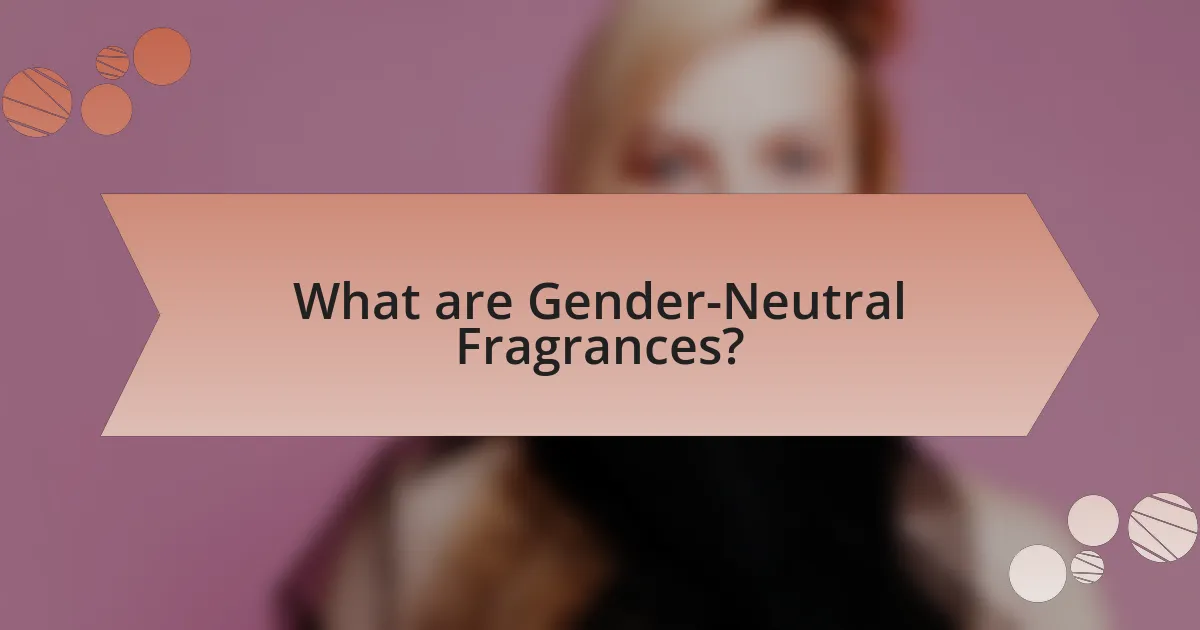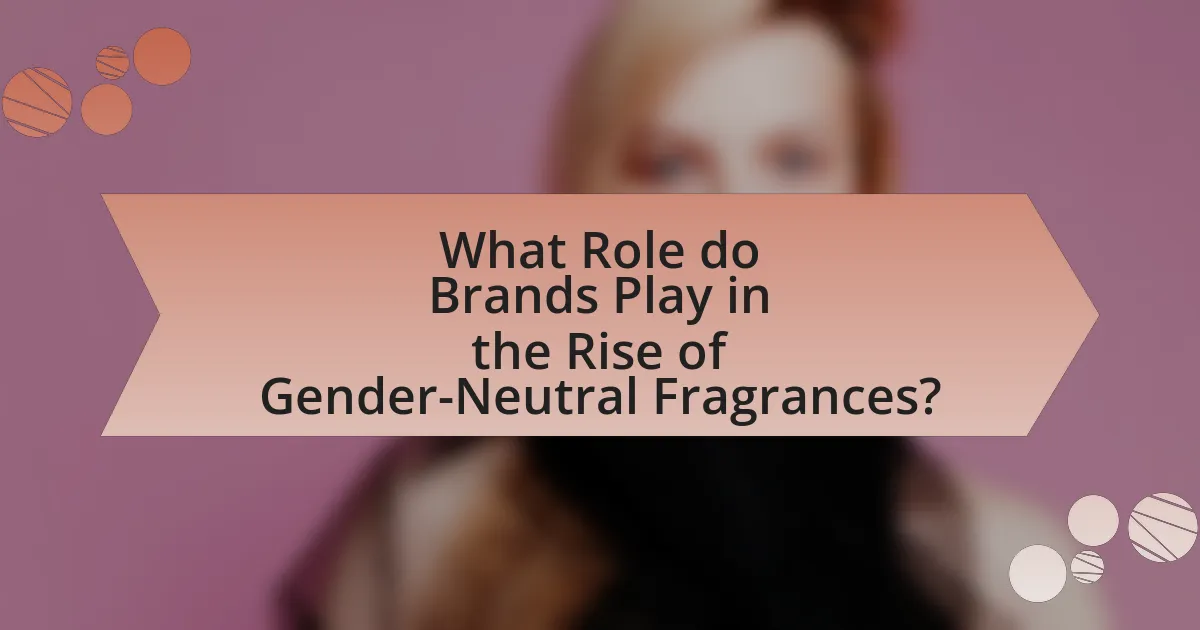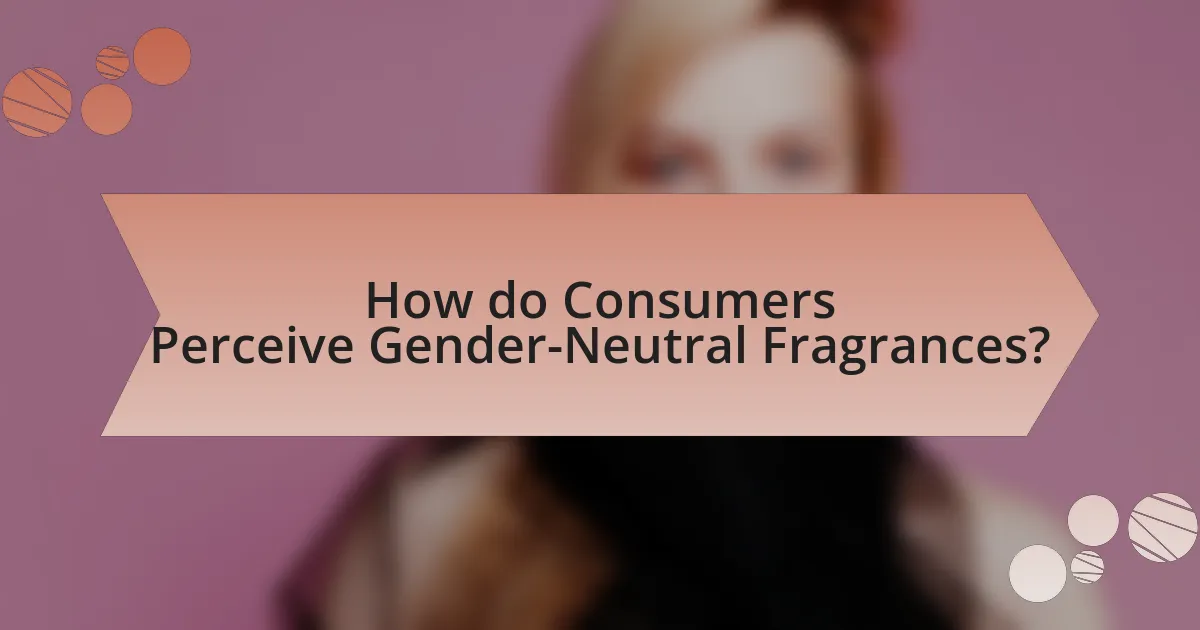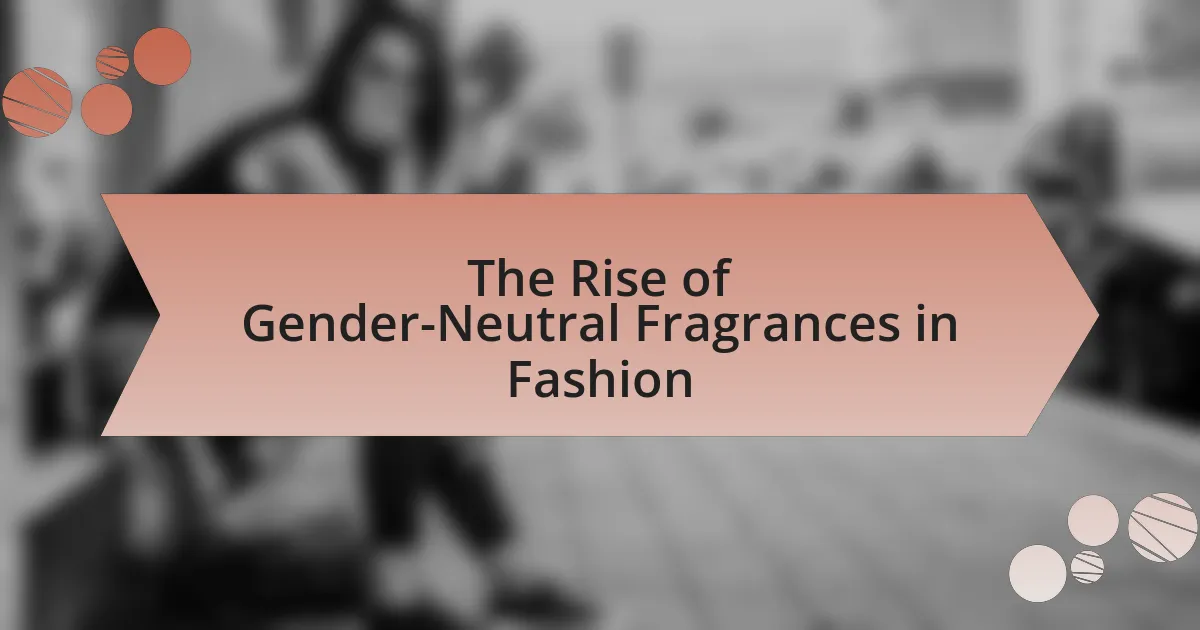The article explores the rise of gender-neutral fragrances in the fashion industry, highlighting their appeal to all genders and the cultural shift towards inclusivity and self-expression. It examines how these fragrances differ from traditional scents, commonly featuring a balanced blend of notes that defy gender stereotypes. The increasing demand for gender-neutral options is driven by changing consumer preferences, particularly among younger generations, and is supported by major brands adapting their marketing strategies to promote inclusivity. Additionally, the article discusses the ingredients, scent profiles, and societal changes influencing this trend, as well as the challenges brands face in promoting gender-neutral fragrances.

What are Gender-Neutral Fragrances?
Gender-neutral fragrances are scents designed to be appealing to all genders, transcending traditional male and female fragrance categories. These fragrances often feature a balanced blend of notes that do not conform to stereotypical gender associations, such as floral or fruity for women and woody or musky for men. The rise of gender-neutral fragrances reflects a broader cultural shift towards inclusivity and self-expression, with many brands now offering unisex options to cater to diverse consumer preferences. This trend is supported by market research indicating that a significant portion of consumers, particularly younger generations, prefer products that defy conventional gender norms.
How do Gender-Neutral Fragrances differ from Traditional Fragrances?
Gender-neutral fragrances differ from traditional fragrances primarily in their formulation and marketing approach, as they are designed to appeal to all genders rather than conforming to stereotypical masculine or feminine scent profiles. Traditional fragrances often emphasize distinct gender characteristics, with floral notes typically associated with femininity and woody or spicy notes linked to masculinity. In contrast, gender-neutral fragrances utilize a blend of various scent notes that can be appreciated by anyone, promoting inclusivity. This shift reflects broader societal changes towards gender fluidity and equality, as evidenced by the increasing number of brands launching unisex lines, such as Calvin Klein’s CK One, which debuted in 1994 and set a precedent for gender-neutral marketing in the fragrance industry.
What ingredients are commonly used in Gender-Neutral Fragrances?
Common ingredients used in gender-neutral fragrances include citrus notes, floral elements, woody bases, and aromatic herbs. Citrus notes like bergamot and lemon provide freshness, while floral elements such as jasmine and lavender add complexity. Woody bases, including sandalwood and cedar, contribute depth, and aromatic herbs like basil and mint enhance the overall scent profile. These ingredients are chosen for their versatility and ability to appeal to a broad audience, reflecting the inclusive nature of gender-neutral fragrances.
How do scent profiles vary in Gender-Neutral Fragrances?
Scent profiles in gender-neutral fragrances typically blend notes traditionally associated with both masculine and feminine scents, creating a balanced olfactory experience. These fragrances often incorporate a mix of floral, woody, citrus, and herbal notes, allowing for versatility and appeal to a broader audience. For example, a gender-neutral fragrance may feature citrus top notes, floral middle notes, and earthy base notes, which together create a harmonious scent that does not lean towards a specific gender. This approach reflects a growing trend in the fragrance industry, where brands aim to break down traditional gender barriers and cater to individual preferences rather than societal norms.
Why is the Demand for Gender-Neutral Fragrances Increasing?
The demand for gender-neutral fragrances is increasing due to a growing societal shift towards inclusivity and the rejection of traditional gender norms. This trend is supported by market research indicating that consumers, particularly younger generations, prefer products that reflect their identity without being confined to gender stereotypes. For instance, a 2021 study by Mintel found that 62% of Gen Z consumers are interested in gender-neutral products, highlighting a significant market opportunity for brands that embrace this approach.
What societal changes are influencing this trend?
The societal changes influencing the rise of gender-neutral fragrances in fashion include the increasing acceptance of non-binary and gender-fluid identities. This shift is reflected in the growing demand for products that do not conform to traditional gender norms, as evidenced by a 2021 report from McKinsey & Company, which noted that 60% of Gen Z consumers prefer brands that are inclusive of all genders. Additionally, the movement towards sustainability and ethical consumption has led consumers to seek out brands that align with their values, further driving the popularity of gender-neutral fragrances.
How do consumer preferences shape the fragrance market?
Consumer preferences significantly shape the fragrance market by driving demand for specific scent profiles and product types. As consumers increasingly seek gender-neutral options, brands are adapting their offerings to include fragrances that appeal to a broader audience, reflecting a shift in societal norms and values. For instance, a report by Mintel in 2021 indicated that 50% of consumers aged 16-24 prefer unisex fragrances, prompting brands to innovate and create products that cater to this demographic. This trend influences marketing strategies, packaging designs, and overall product development within the fragrance industry, as companies aim to align with evolving consumer expectations and preferences.

What Role do Brands Play in the Rise of Gender-Neutral Fragrances?
Brands play a crucial role in the rise of gender-neutral fragrances by actively promoting inclusivity and challenging traditional gender norms in the fragrance market. Major brands like Calvin Klein and Gucci have launched gender-neutral scents, which cater to a growing consumer demand for products that transcend binary gender classifications. According to a 2021 report by Mintel, 50% of consumers aged 16-24 are interested in gender-neutral fragrances, indicating a significant market shift. This trend is further supported by brands that emphasize diversity in their marketing campaigns, appealing to a broader audience and fostering a sense of belonging among consumers.
How are Fashion Brands Adapting to the Gender-Neutral Trend?
Fashion brands are adapting to the gender-neutral trend by creating unisex collections that appeal to a broader audience. This shift includes the introduction of gender-neutral fragrances, which are designed to be inclusive and cater to diverse consumer preferences. For instance, brands like Calvin Klein and Gucci have launched fragrances that do not adhere to traditional gender norms, emphasizing fresh and floral notes that can be enjoyed by anyone. This approach is supported by market research indicating that 50% of consumers are interested in gender-neutral products, reflecting a significant demand for inclusivity in fashion.
What marketing strategies are effective for Gender-Neutral Fragrances?
Effective marketing strategies for gender-neutral fragrances include inclusive branding, targeted social media campaigns, and collaborations with diverse influencers. Inclusive branding ensures that the product appeals to a broad audience by avoiding gender-specific language and imagery, which research shows can increase market reach by up to 30%. Targeted social media campaigns leverage platforms like Instagram and TikTok, where younger consumers, who are more open to gender-neutral products, engage. Collaborations with diverse influencers help to authentically connect with various demographics, enhancing brand credibility and visibility. These strategies collectively foster a welcoming environment for consumers, driving sales and brand loyalty in the growing market for gender-neutral fragrances.
Which brands are leading the way in this movement?
Brands leading the way in the movement of gender-neutral fragrances include Byredo, Le Labo, and Maison Margiela. Byredo has gained recognition for its unisex scents like “Gypsy Water,” which appeals to a diverse audience. Le Labo’s “Santal 33” has become iconic for its gender-neutral appeal, often celebrated for its woody and spicy notes. Maison Margiela’s “Replica” line features fragrances designed to evoke memories and experiences, transcending traditional gender norms. These brands exemplify the shift towards inclusivity in the fragrance industry, reflecting changing consumer preferences for non-binary options.
What Challenges do Brands Face in Promoting Gender-Neutral Fragrances?
Brands face significant challenges in promoting gender-neutral fragrances, primarily due to entrenched societal norms and consumer perceptions regarding gender and scent. Traditional marketing strategies often rely on gender-specific messaging, which can alienate potential customers who identify outside of binary categories. Additionally, brands may struggle with limited market research on consumer preferences for gender-neutral products, leading to uncertainty in product development and marketing approaches. A study by the NPD Group in 2021 indicated that 30% of consumers are interested in gender-neutral fragrances, highlighting a growing market but also the need for brands to adapt their strategies to effectively reach this demographic.
How do traditional gender norms impact marketing efforts?
Traditional gender norms significantly impact marketing efforts by dictating the ways products are presented and targeted to consumers. Marketers often rely on established stereotypes, such as associating floral scents with femininity and woody scents with masculinity, which can limit the appeal of products like fragrances. For instance, a study by the American Psychological Association found that gendered marketing can reinforce societal expectations, leading to a narrower consumer base. This reliance on traditional norms can hinder brands from reaching a broader audience, particularly as consumer preferences shift towards gender-neutral options, reflecting a growing demand for inclusivity in marketing strategies.
What misconceptions exist about Gender-Neutral Fragrances?
One misconception about gender-neutral fragrances is that they lack distinctiveness and are bland. In reality, gender-neutral fragrances are designed to appeal to a wide audience by incorporating a diverse range of notes, allowing for unique and complex scent profiles. For example, many gender-neutral fragrances feature a blend of floral, woody, and citrus notes, creating a rich olfactory experience that can be just as vibrant and memorable as traditional gender-specific scents. This diversity in formulation challenges the stereotype that gender-neutral options are less expressive or appealing.

How do Consumers Perceive Gender-Neutral Fragrances?
Consumers perceive gender-neutral fragrances as inclusive and versatile, reflecting a shift towards breaking traditional gender norms in scent preferences. Research indicates that 62% of consumers appreciate fragrances that are marketed as gender-neutral, viewing them as more personal and expressive of individual identity rather than conforming to societal expectations. This perception aligns with broader trends in the fashion industry, where brands are increasingly adopting gender-neutral marketing strategies to appeal to a diverse consumer base.
What are the Benefits of Choosing Gender-Neutral Fragrances?
Choosing gender-neutral fragrances offers inclusivity, versatility, and broader appeal. These fragrances cater to a diverse audience, allowing individuals to express their identity without conforming to traditional gender norms. The rise in popularity of gender-neutral scents reflects changing societal attitudes towards gender, with a 2021 report from the NPD Group indicating that 30% of fragrance sales were attributed to unisex options, showcasing a significant market shift. This trend not only promotes personal expression but also encourages brands to innovate, leading to unique scent profiles that appeal to a wider range of consumers.
How do Gender-Neutral Fragrances promote inclusivity?
Gender-neutral fragrances promote inclusivity by eliminating traditional gender norms associated with scent, allowing individuals to express their identity freely. These fragrances are designed to appeal to a broad audience, regardless of gender, which fosters a sense of belonging and acceptance among diverse consumer groups. The rise of gender-neutral fragrances reflects a cultural shift towards embracing individuality and breaking down barriers, as evidenced by the increasing number of brands that offer unisex options, such as Calvin Klein’s CK One, which was one of the first mainstream gender-neutral fragrances launched in the 1990s. This trend not only caters to a wider market but also encourages conversations about gender fluidity and personal expression in the beauty industry.
What environmental considerations are associated with Gender-Neutral Fragrances?
Environmental considerations associated with gender-neutral fragrances include the sourcing of ingredients, packaging sustainability, and the impact of synthetic chemicals. The production of these fragrances often relies on natural resources, which can lead to deforestation and biodiversity loss if not managed responsibly. For instance, the use of essential oils derived from plants can contribute to habitat destruction if the plants are harvested unsustainably. Additionally, many brands are increasingly adopting eco-friendly packaging to reduce plastic waste, which is crucial given that the global fragrance industry generates significant plastic pollution. Furthermore, the presence of synthetic chemicals in some fragrances raises concerns about water pollution and potential harm to aquatic ecosystems, as these substances can enter waterways during manufacturing and disposal. These factors highlight the importance of sustainable practices in the formulation and distribution of gender-neutral fragrances.
How can Consumers Choose the Right Gender-Neutral Fragrance?
Consumers can choose the right gender-neutral fragrance by identifying their personal scent preferences and testing various options to find a match. Gender-neutral fragrances often feature a blend of notes that appeal to a wide audience, such as citrus, floral, or woody elements. To ensure a suitable choice, consumers should sample fragrances on their skin, as body chemistry can alter how a scent develops. Additionally, reading reviews and seeking recommendations can provide insights into popular gender-neutral options. Research indicates that the demand for gender-neutral fragrances has increased by 30% over the past five years, reflecting a shift in consumer preferences towards inclusivity in personal care products.
What tips should consumers consider when selecting a fragrance?
Consumers should consider their personal preferences, skin chemistry, and the fragrance notes when selecting a fragrance. Personal preferences dictate the types of scents that resonate with an individual, while skin chemistry can alter how a fragrance smells once applied, making it essential to test fragrances on the skin before purchasing. Additionally, understanding fragrance notes—top, middle, and base—helps consumers choose scents that align with their desired experience. Research indicates that fragrances can evoke emotional responses and memories, further emphasizing the importance of selecting a scent that feels personally meaningful.
How can personal preferences guide fragrance choices?
Personal preferences significantly guide fragrance choices by influencing the selection of scents that resonate with individual tastes and emotional responses. For instance, a person who enjoys floral notes may gravitate towards fragrances that feature jasmine or rose, while someone who prefers woody or spicy scents might choose fragrances with cedar or pepper. Research indicates that personal experiences and cultural backgrounds shape these preferences, as individuals often associate specific scents with memories or feelings, thereby impacting their purchasing decisions. This alignment of fragrance with personal identity is particularly relevant in the context of the rise of gender-neutral fragrances, where consumers seek scents that reflect their unique personalities rather than traditional gender norms.
What Future Trends can be Expected in Gender-Neutral Fragrances?
Future trends in gender-neutral fragrances will likely include increased personalization, sustainable sourcing, and innovative scent compositions. Personalization will allow consumers to create unique fragrances that reflect their individual identities, moving away from traditional gender norms. Sustainable sourcing will become a priority as brands focus on eco-friendly ingredients and packaging, responding to consumer demand for environmentally responsible products. Additionally, innovative scent compositions that blend unconventional notes will emerge, appealing to a broader audience and challenging the binary classification of fragrances. These trends are supported by market research indicating a growing consumer preference for inclusivity and sustainability in the fragrance industry.
How might the fragrance industry evolve in response to consumer demands?
The fragrance industry may evolve by increasingly offering gender-neutral fragrances to meet the growing consumer demand for inclusivity and diversity. This shift is evidenced by a rise in brands launching unisex scents, reflecting changing societal norms and preferences. According to a report by Mintel, 50% of consumers aged 16-24 prefer gender-neutral products, indicating a significant market trend. As a result, fragrance companies are likely to reformulate existing products and develop new lines that appeal to a broader audience, thereby aligning their offerings with contemporary consumer values.
What innovations are on the horizon for Gender-Neutral Fragrances?
Innovations on the horizon for gender-neutral fragrances include the development of customizable scent profiles using AI technology, which allows consumers to create personalized fragrances that reflect their individual preferences without gender constraints. Additionally, brands are increasingly focusing on sustainable and eco-friendly ingredients, responding to consumer demand for environmentally conscious products. Research indicates that the global fragrance market is shifting towards inclusivity, with a projected growth rate of 5.5% annually for gender-neutral products, highlighting the rising consumer interest in this category.
What Practical Tips can Help Consumers Navigate the Gender-Neutral Fragrance Market?
To navigate the gender-neutral fragrance market effectively, consumers should focus on understanding scent families, testing fragrances on their skin, and considering personal preferences over traditional gender labels. Familiarizing oneself with scent families, such as floral, woody, or citrus, helps consumers identify fragrances that align with their tastes. Testing fragrances on the skin is crucial, as body chemistry can alter how a scent smells, making it essential to experience the fragrance in real-time. Additionally, prioritizing personal preferences allows consumers to choose scents that resonate with them, regardless of marketing labels. This approach is supported by the growing trend of gender-neutral fragrances, which emphasizes individual expression over conventional gender norms.
